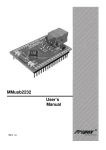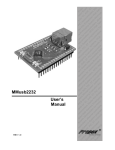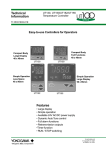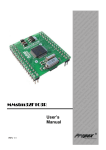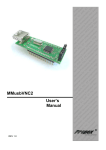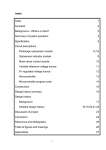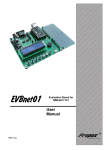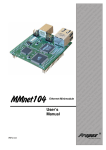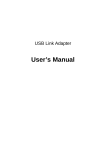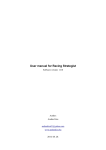Download MMusb245RL User`s manual
Transcript
MMusb245RL User’s manual , lu ard ST Sta rve a , e o Ev B VR ers b S l d n io 1, A trol We mo t i a ‘5 in ron ed r c M e fo cro dd s th e rd s i e b m m oa rs, pe C E B e S I P its ng roll gh r K pi nt Hi fo r y o rte tot roc FID ers s o c r Pr mi s, R mm lle a rs or ler gr tro f ol n o B r o c p es tr C ul on m cro , P or t c ste mi ms s f e d e n Sy T st oar lS n y I , s ro B ed PIC or ion ont b e s , c R ce luat cro W V o A pr va mi ed iE ro dd ic ng PIC be ds m M ni T, m ar rs, g E i S o s , ts e B de VR Ki ng roll t h i r , A rte typ on Hig 1 c a ‘5 St oto ro ID r eic F s P r m m R le rs or s, ram rle r f g nt rv s lle Se ule tro pro oco s r s, od on m t c tem mic em i n ne t r Sys ST ys oe s , B h et d In PIC sor on i c ee R, oce uat mi p l r V S A op va IC er cr P E b o , f i g T rs s M nin , S Em g s r R it ig in le ol des , AV er K typ B `51 tart roto roC S s P mic , P for s r r r rs ds olle rwe s fo lle r a tr ro Se ule ont am n o d c b r c ro We imo et rog p co d in ern e o M m dd ds eth ste icr ar rs, Sy T m r Bo olle In , S so tr ed IC oce ign P s co Spe R, opr De r V c h B Rtion ig r A Mi C H f o rs P lua s, 1 onevasolution s lle Many ideas r e o tem E rds m ntr g s a co Sy nin Bo Introduction Mmusb245RL is a low-cost integrated module designed for data transmission in and out of a peripheral device or a PC computer via USB interface. It is based on FTDI`s FT245R chip. MMusb245RL allows data transfer 1MB/s fast. It’s a simple FIFO device and represents an interface between USB and microcontroller’s parallel interface. There is a USB cable attached to the module. Windows drivers allow to emulate a serial port on the PC and that provides for upgrading applications in which transmission over a RS232 serial link was used. Choosing our Minimodule is the first step for projects, which should be done in a short time. MMusb245 could be used as a part of a prototype eliminating the necessity of designing a circuit board and in the final circuit in which the module is fitted “sandwichlike” on top. MMusb245RL is made in two-layer printed circuit board technology with a solid ground plane. All signals are accessible via 24 pins, in a 100mils raster (2.54 mm) which allows to use this module with prototype PCBs. Integral power control makes the MMusb245RL a perfect choice for USB bus-powered, high power designs as well as self- and low-powered products. We wish you much success in designing and using new devices ! MMusb245RL Features Summary • • • • • • • • • • • • • • • • • • • • • Data transmission over USB with speeds up to 1MB/s 256B of FIFO transmit buffer, 128B FIFO receive buffer integrated 1024bit internal EEPROM Simple interface to MCU / PLD/ FPGA logic with a 4 wire handshake FTDI’s drivers provided Integrated Power-On-Reset circuit with optional in and out reset pins Integrated AVCC filter Interface and USB mode configurable in EEPROM memory Bit-Bang Mode feature (advanced synchronous and asynchronous with two strobe signals) Support for bus powered, self powered and high-power bus powered USB configuratoins Integrated level converter provides interfacing between 5V and 3.3V logic Integrated FIFO logic level converter Integrated 3.3V LDO regulator for USB I/O Power supply from 3.3V to 5.25V USB bulk data transmit mode Wake-up capability when in suspend mode Each device has its own unique ID (FTDIChip-IDTM feature) UHCI / OHCI / EHCI host controller compatible USB 1.1 and 2.0 compatible Standard 0.6in wide 24 pin DIP socket Standard USB connector, B type 2 Improved features of the FT245R FT245R converter is a functional equivalent of the FT232R. The only essential difference between theese devices from a user’s point of view is that the UART of the latter is replaced with a 8-bit parallel port which interface is similar to a classical FIFO (First In First Out) memory interface . Just like the FT232R, the FT245R is backward compatible with the previous generation FT245BM device but far more integrated. New features: - integrated EEPROM memory - integrated USB line resistors - built in clock signal generator, accessible from the outside byexternal elements - unique serial number (FTDIChipID) Possible applications • • • • • • • • USB to RS245 converters Expanding capabilities of peripheral devices USB Instrumentation USB cable and wireless modems USB Industrial Control Audio and Video transmission Toys Metrology General Description MMusb245RL is housed in a single 24-pin module. A single USB port is converted to FIFO interface, which allows communicating with external devices via a 8-bits bus. To send data from the peripheral to the host computer, simply write the byte-wide data into the module when TXE is low. If the transmit buffer fills up or is busy storing the previously written byte, the device keeps TXE high in order to stop further data from being written until some of the FIFO data has been transferred over USB to the host. When the host sends data to the peripheral over USB, the device will switch RXF low to let the peripheral know that at least one byte of data is available. The peripheral reads data until RXF goes high which means that there is no more data to read. The FTDI company provides a Virtual COM Port (VCP) driver with its chip making the peripheral look like a standard COM port to the PC application software. Most of the existing software should have no problem cooperating with VCP, you only need to change the ports it uses to the ones created by the VCP driver. Using VCP the programmer can communicate with the device the same way as with a regular PC COM port – using Windows VCOMM API or COM port’s libraries. The driver incorporates functions defined for the FTDI’s D2XX drivers, which allows the programmer to integrate the device with the program using Windows DLL. 3 Virtual Com Port (VCP) drivers • Windows 98/ 98 SE / 2000 / ME / XP, MacOS, Linux 2.4 or newer D2XX (Direct USB drivers + DLL S/W interface) • Windows 98 / 98 SE / 2000 / ME / XP / Vista, Linux 2.4 and newer MMusb245RL Module Simplified Block Diagram Figure 1. MMusb245RL simplified block diagram Functional Blocks Description 12MHz Oscillator The built-in resonator generates a reference clock signal (12MHz) for the x4 clock signal frequency multiplier. It is used as a clock source for internal modules (SIE, USB Protocol Engine, FIFO controller). UART/FIFO general purpose controller includes: • Integrated Power-On-Reset (POR) Circuit • Integrated Level Converter on FIFO interface and control signals • Power Management control for USB devices • Send Immediate / WakeUp (SI / WU) signal • Lower Suspend Current • Programmable FIFO Tx Buffer Timeout • Bit Bang Mode • Internal EEPROM • USB 2.0 full speed • 3.3V LDO Regulator • x4 frequency multiplier • Serial Interface Engine (SIE) 4 • • • FIFO Receive Buffer (128 bytes) FIFO Transmit Buffer (384 bytes) FIFO Controller (more information on www.ftdichip.com) EEPROM memory EEPROM allows to customize the USB VID, PID, Serial Number, Product Description Strings and the Power Descriptor value. EEPROM memory is integrated in the FT245R. It is programmable using a utility program available on FTDI’s web site www.ftdichip.com and our homepage www.propox.com. Module Pin-Out Figure 2. Mmusb245RL Pin-Out (elements side) 5 Pin Definitions Pin mode Description 1 Pin’s name RXF output 2 TXE output 3 WR output 4 RD input 5 6 7 8 9 10 11 12 15 D7 D6 D5 D4 D3 D2 D1 D0 RST I/O I/O I/O I/O I/O I/O I/O I/O input 16 RSO output 18 20 3V3 PWRN output output 22 23 VIO VEX input input 24 VPO output When low, there is data available in the Rx FIFO . High state indicates that the receive buffer is empty. Low state indicates that the FIFO is ready to be written to. High state indicates the transmit buffer being filled or busy writing the last byte. Writes a data byte from D0..D7 into the transmit FIFO Buffer when WR changes from high to low. Enables current FIFO data byte on D0..D7 when low. Fetches the next FIFO data byte (if available) from the Receive FIFO Buffer when RD changes from low to high. In high state D0..D7 are in high impedance state. Data bus line (bit 7) Data bus line (bit 6) Data bus line (bit 5) Data bus line (bit 4) Data bus line (bit 3) Data bus line (bit 2) Data bus line (bit 1) Data bus line (bit 0) Can be used by an external device to reset the MMusb245RL. If not required, tie to VCC Output of the internal Reset Generator. Stays in high impedance state for ~5ms after VCC exceeds 3.5V and the internal clock start up, then clamps its output to the 3.3V output of the internal regulator. Output of the internal LDO regulator. Goes low when configuration of the device through USB is done. Goes high when USB is on hold. Sets voltages on communication pins Use for applying main power (4.4 to 5.25 Volts) to the module. Connect to VPO if module is to be powered by the USB port (typical configuration) Power from USB port. Additionaly there are pins on the PCB which set the method that the device is powered. Shorted VEX and VPO pins cause the device to be powered from USB. 3 remaining pins set the voltage level: 3.3V(VIO-3V3) or 5V(VIO-VEX). 6 Jumpers Figure 3. Mmusb245RL jumpers view (top layer) Jumper JP1 JP2 Description VEX and VPO pins. VEX, VIO, 3V3 pins. 7 Technical data Dimensions Weight Power supply : 45mm x 20mm x 15mm : ~ 60 g : 5V Mechanical Dimensions Dimensions in mils. 1mil – 1/1000 inch 100mils = 2,54mm 8 Standard Device Configuration Examples USB Bus Powered (jumpers configuration - red) Figure 4. Mmusb245RL USB bus powered Figure 4 illustrates a typical USB bus powered configuration. A USB Bus Powered device gets its power from the USB bus. Basic rules for USB Bus powered devices are as follows: a) On plug-in, the device must draw no more than 100mA b) On USB Suspend the device must draw no more than 500uA. c) A High Power USB Bus Powered Device (one that draws more than 100mA) should be connected to PWREN# line to keep the current draw under 100mA working and 500uA in suspend mode d) A device that consumes more than 100mA can not be connected to USB hub’s power lines. e) No device can draw more that 500mA from the USB Bus. The USB power descriptor option in the EEPROM should be programmed to match the actual current intake. 9 Externally powered configuration Figure 5. Mmusb245RL external power supply Figure 5 illustrates a typical USB self powered configuration. A USB Self Powered device gets its power from its own power supply and does not draw current from the USB bus. Basic rules for USB Self power devices are as follows: a) A Self-Powered device should not force current down the USB bus when the USB Host or Hub Controller is powered down. b) A Self-Powered device can take as much current as it needs during normal operation and USB suspend as long as it has its own power source. c) A Self-Powered device can be used with any USB Host and both Bus and Self Powered USB Hubs. The USB power descriptor option in the EEPROM should be programmed to a value of zero (self powered). 10 Bus powered circuit with power control – 5V power supply Figure 6. Mmusb245RL Bus powered circuit with power control – 5V power supply In case of configuration as shown on figure 6 the jumpers are not necessary. Figure 6 illustrates USB bus powered circuit configuration of Musb245RL. External (5V) devices can be powered from this module. Basic rules for USB Self power devices are as follows: a) The external device must have its own power-on-reset circuit to be able to reset when going back from USB suspend mode b) The Pull-down option in internal EEeprom should be set to Suspend. Pin PWREN# in internal EEeprom should be used for switching the supply to external circuits. c) For devices, which take more than 100mA current from the USB (no device can draw more that 500mA from the USB Bus) max power parameter in internal EEPROM should be configured, which informs the system of required power needs. Technical support If You have problems with MMusb245RL, please contact us at [email protected]. 11 Schematic 12













